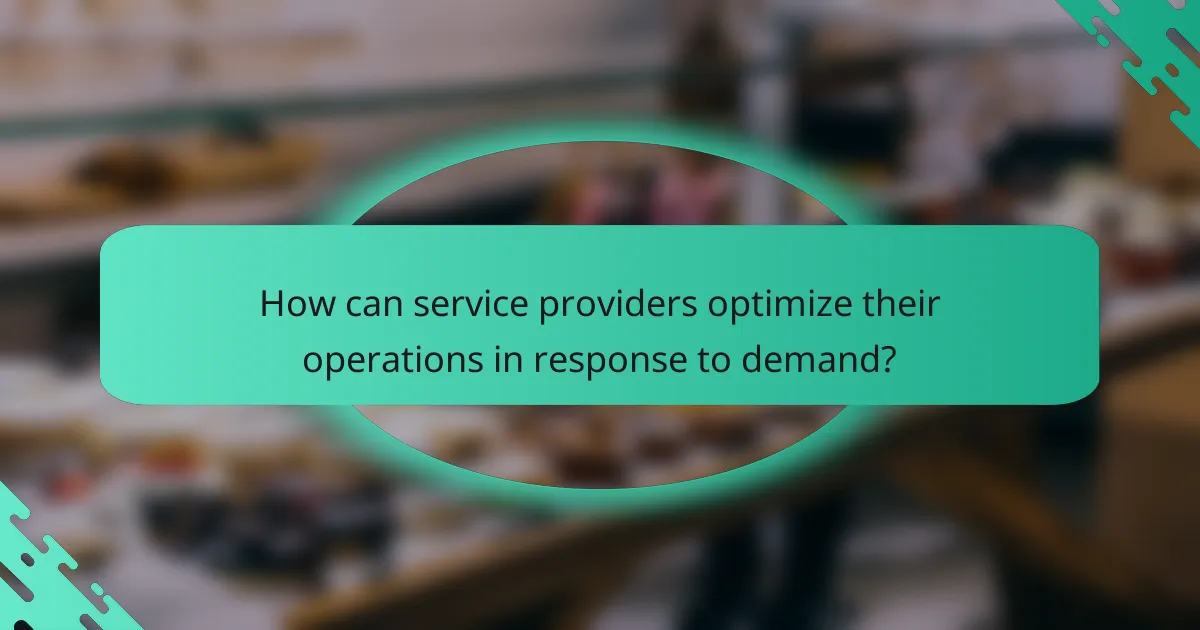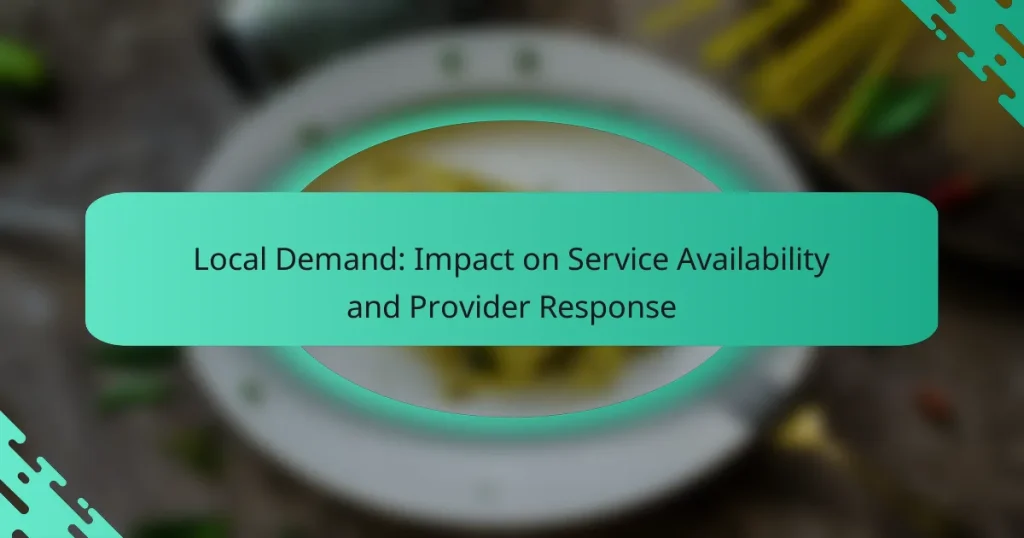Local demand plays a crucial role in shaping service availability and provider responsiveness in urban areas like Los Angeles. As demand fluctuates, it directly affects the capacity and scheduling of services offered by providers, with high demand often leading to more options and low demand potentially resulting in reduced availability. By understanding the geographic and resource-related factors that influence provider response times, services can be optimized to better meet community needs.

How does local demand affect service availability in Los Angeles?
Local demand significantly impacts service availability in Los Angeles by influencing how much capacity providers can offer and how they schedule their services. High demand can lead to increased service options, while low demand may result in reduced availability or fewer providers in certain areas.
Increased demand leads to higher service capacity
When demand for services rises in Los Angeles, providers often respond by increasing their service capacity. This can mean adding more staff, extending hours of operation, or expanding service areas. For example, ride-sharing companies may deploy more vehicles during peak hours to accommodate the influx of users.
In sectors like food delivery or healthcare, higher demand can prompt businesses to invest in additional resources or technology to streamline operations. This ensures they can meet customer expectations and maintain service quality during busy periods.
Service providers adjust schedules based on demand
Service providers in Los Angeles frequently adjust their schedules to align with local demand patterns. For instance, public transportation services may increase frequency during rush hours while reducing it during off-peak times. This helps to optimize resource use and improve customer satisfaction.
Providers can utilize data analytics to predict demand fluctuations and modify their schedules accordingly. This proactive approach not only enhances service availability but also minimizes wait times for users, making the overall experience more efficient.

What factors influence provider response times?
Provider response times are primarily influenced by geographic distance from the service area and the availability of necessary resources. Understanding these factors can help in anticipating delays and improving service efficiency.
Distance from service area impacts response time
The farther a provider is from the service area, the longer it typically takes to respond. For instance, a service provider located within a few kilometers may reach a client in under 30 minutes, while those situated further away might take over an hour.
When planning service delivery, consider the average travel times in your area. Urban settings often have quicker response times due to better infrastructure, while rural areas may experience significant delays due to longer distances and fewer available routes.
Availability of resources affects speed
Resource availability, such as personnel, vehicles, and equipment, directly impacts how quickly a provider can respond. A service provider with a well-staffed team and sufficient vehicles can typically handle requests faster than one that is understaffed or lacks necessary tools.
For example, during peak demand periods, providers with a surplus of resources can maintain quicker response times, while those with limited capacity may face delays. It’s crucial for service providers to assess their resource levels regularly to ensure they can meet demand effectively.

What strategies can local service providers implement to meet demand?
Local service providers can adopt various strategies to effectively meet demand, ensuring they remain responsive and competitive. Key approaches include expanding their workforce during peak times and utilizing technology for efficient scheduling.
Expand workforce during peak times
Expanding the workforce during peak demand periods allows service providers to maintain quality and responsiveness. This can involve hiring temporary staff or reallocating existing employees to critical areas where demand surges, such as weekends or holidays.
Providers should assess historical data to identify peak times and plan accordingly. For example, a local restaurant might increase staff during dinner hours or special events to accommodate higher customer volume.
Utilize technology for efficient scheduling
Leveraging technology for scheduling can significantly enhance a service provider’s ability to meet demand. Tools such as scheduling software can optimize staff allocation based on real-time data and predicted demand patterns.
Providers should consider implementing systems that allow for dynamic scheduling, which adjusts staff levels based on current demand. This approach not only improves efficiency but also helps reduce labor costs during slower periods. For instance, a local cleaning service might use an app to assign jobs based on employee availability and client needs, ensuring optimal service delivery.

How do permits and regulations impact service delivery?
Permits and regulations significantly influence service delivery by establishing the legal framework within which service providers operate. Compliance with local laws can determine the types of services offered, their availability, and the speed at which they can be initiated.
Local zoning laws dictate service capabilities
Local zoning laws are critical as they define what types of services can be provided in specific areas. For instance, a residential zone may restrict commercial services, limiting options for residents. Understanding these regulations is essential for service providers to align their offerings with local requirements.
Additionally, zoning laws can impact the scale of operations. For example, a service provider may be limited to smaller facilities in residential areas, affecting their capacity to serve larger client bases. Providers must assess local zoning regulations to ensure compliance and optimize service delivery.
Permitting processes can delay service initiation
The permitting process is often a lengthy procedure that can delay the start of service delivery. Providers must navigate various bureaucratic steps, which may include application submissions, inspections, and approvals. This can take weeks or even months, depending on the locality and the complexity of the service.
To mitigate delays, service providers should familiarize themselves with the specific permitting requirements in their area. Engaging with local authorities early in the process can streamline approvals. Additionally, maintaining organized documentation and adhering to submission deadlines can help avoid common pitfalls that lead to further delays.

What role does customer feedback play in service improvement?
Customer feedback is crucial for service improvement as it provides insights into customer experiences and expectations. By actively gathering and analyzing feedback, service providers can make informed decisions to enhance their offerings and address any shortcomings.
Feedback helps identify service gaps
Customer feedback is instrumental in pinpointing areas where services may be lacking. For instance, if multiple customers report long wait times or difficulty accessing certain features, providers can prioritize these issues for resolution. Regularly reviewing feedback allows businesses to adapt and refine their services to better meet customer needs.
To effectively identify service gaps, companies should implement structured feedback mechanisms such as surveys or suggestion boxes. This can help in gathering specific insights that can lead to targeted improvements, ultimately enhancing customer satisfaction.
Customer reviews influence provider reputation
Customer reviews significantly impact a provider’s reputation in the market. Positive reviews can attract new customers, while negative feedback can deter potential clients. In today’s digital age, online reviews are often the first point of contact for prospective customers, making it essential for providers to manage their online presence actively.
Providers should encourage satisfied customers to leave positive reviews and promptly address any negative feedback. This proactive approach not only helps in maintaining a good reputation but also demonstrates a commitment to customer satisfaction, which can lead to increased loyalty and trust.

How can service providers optimize their operations in response to demand?
Service providers can optimize their operations by leveraging data analytics and enhancing communication with clients. These strategies enable providers to anticipate demand fluctuations and respond more effectively, ensuring service availability aligns with customer needs.
Implement data analytics for demand forecasting
Data analytics plays a crucial role in demand forecasting by allowing service providers to analyze historical trends and predict future service needs. By utilizing tools such as predictive modeling and machine learning, providers can identify patterns that inform staffing and resource allocation.
For effective forecasting, providers should consider collecting data from various sources, including customer feedback, seasonal trends, and market changes. Regularly updating these analytics can help maintain accuracy and adapt to evolving demand.
Common pitfalls include relying on outdated data or failing to account for sudden market shifts. Providers should establish a routine for reviewing and adjusting their forecasts to mitigate these risks.
Streamline communication with clients
Effective communication with clients is essential for optimizing service availability. Providers should establish clear channels for clients to express their needs and feedback, which can help identify demand surges or service gaps quickly.
Implementing tools such as customer relationship management (CRM) systems can facilitate better interactions and ensure that client inquiries are addressed promptly. Regular updates about service changes or availability can also enhance client satisfaction and trust.
To improve communication, providers should avoid jargon and ensure that information is accessible and straightforward. Regular training for staff on communication best practices can further enhance client interactions and service responsiveness.

What are the emerging trends in local service demand?
Emerging trends in local service demand reflect changing consumer preferences and technological advancements. Key shifts include increased reliance on digital platforms and a growing preference for eco-friendly service options.
Increased reliance on digital platforms
Consumers are increasingly turning to digital platforms for local services, driven by convenience and accessibility. This trend allows users to compare options, read reviews, and book services from their devices, often leading to quicker decisions.
Service providers must adapt by optimizing their online presence, ensuring their websites and applications are user-friendly. Offering features like online booking, real-time availability, and customer support through chat can enhance user experience and satisfaction.
Shift towards eco-friendly service options
There is a notable shift towards eco-friendly services as consumers become more environmentally conscious. This trend encompasses everything from sustainable cleaning products to energy-efficient home repairs, appealing to a market that values sustainability.
Providers can capitalize on this demand by incorporating green practices into their offerings. For instance, using biodegradable materials or implementing energy-saving technologies can attract eco-minded customers and differentiate services in a competitive landscape.


